Menu

By 2050, our world will have nearly 10 billion people, putting a lot of pressure on farming to grow more food. The use of AI in farming will increase from USD 1.7 billion in 2023 to an impressive USD 4.7 billion in 2028.
AI has changed how we farm. It has brought smart farming tools, big-data solutions, and new methods that make sure we have enough food, boost efficiency, and protect the planet. With AI, we can make farming more precise and efficient, meeting the needs of today’s agriculture, such as ensuring food quality and tracking where our food comes from.
Adding AI to farming is a big leap forward. It’s not just about getting better at what we do; it’s about starting a new chapter in farming. This new chapter focuses on using technology to meet the demands of sustainable farming and higher crop yields, changing how we look at farming and its future.
The world’s population will soon hit 10 billion by 2050. With this, the need for food grows more urgent. The agricultural sector must decide how to respond. Should it grow more food from more land, or should it get smarter with technology like agricultural robots and AI? This choice brings both promise and difficulties for the future of farming.
The ways we used to farm are no longer enough to feed everyone. We now look to new methods that use technology like AI and robots. AI is set to play a bigger role in farming, with spending estimated to reach £4.7 billion by 2028.
The IoT in agriculture is also on the rise, with its market expected to hit £84.5 billion by 2031.
Precision farming with AI collects detailed data to help farmers make better decisions. Tools such as See & Spray and Smart Cultivator improve how farming tools work. They aim to make farming more sustainable by saving resources and reducing the harm to our planet.
Even with new technology, agriculture faces big challenges. The amount of land suitable for farming is small, and there are not enough workers. This, along with the climate crisis, makes farming hard. Farming uses a lot of the world’s water and adds to air pollution. AI in farming tries to help by using water more efficiently and cutting down on pollution.
In places where many small farms are, most of the food we eat comes from them. Yet, these farmers often can’t afford new technology. They also find it hard to get loans for buying tech. Making sure small farms can access useful technology is essential for feeding the world.
Using smart, AI-based methods in farming is now not just an option; it’s a must. This step is vital for feeding everyone and for keeping farming safe for the planet and the economy.
| Global Population Projection | AI in Agriculture Spending | IoT in Agriculture Market Size |
|---|---|---|
| 10 Billion by 2050 | £1.7 Billion (2023) | £27.1 Billion (2021) |
| £4.7 Billion (2028) | £84.5 Billion (2031) |
AI is changing how we run farms, dealing with old problems and making them better. It brings smart data use and learning from machines into farming. This makes farming more predictable and less inefficient.
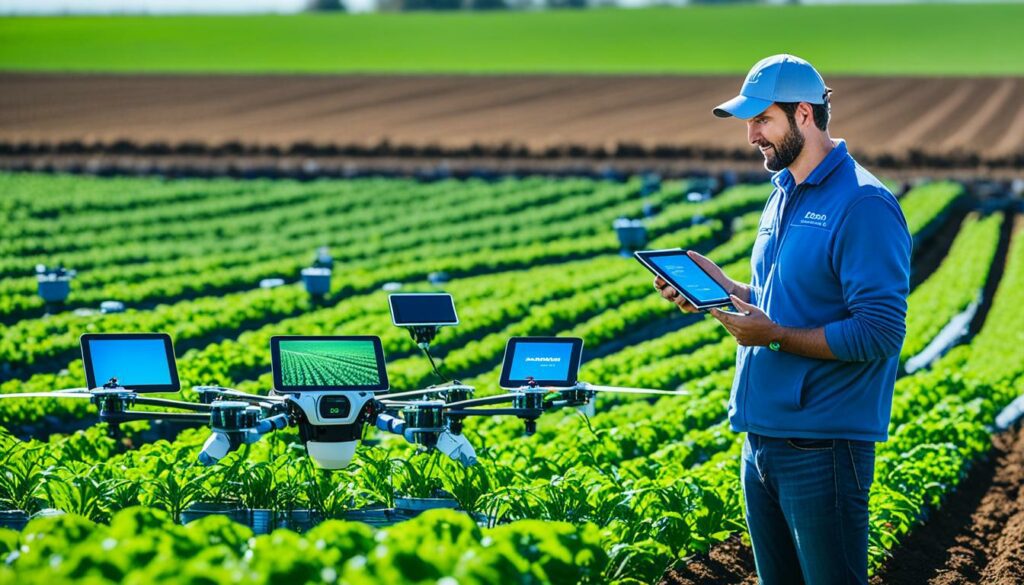
AI is not just a trend; it’s a game-changer in farming. It crunches big data to meet market needs and time planting and harvesting just right. The AI in farming market is set to leap from USD 1.7 billion in 2023 to USD 4.7 billion by 2028, showing its power.
Farms often battle poor soil, changing weather, and lower crop yields. Luckily, AI, like CattleEye for checking cattle health remotely, can make cows and milk better.
AI drones apply pesticides with pinpoint accuracy, cutting pollution. They also manage crops alone, using AI to water only when needed, saving water. AI gives farmers live updates, guiding them to spots that need more water, food, or protection against bugs quickly.
FarmVibes.AI, for instance, forecasts the future and offers support tools based on soil and crop maps. These help farmers get ready for rough weather or other risks ahead of time, preventing big problems and making farms more effective.
AI shines in spotting apple diseases with nearly perfect accuracy. Such a high hit rate for disease checking shows AI’s huge potential in farming.
AI makes farming’s old challenges easier and pushes for greener practices. With the world aiming to feed 10 billion by 2050, AI’s part in securing food and sustainable farming is key.
The use of AI is changing farming by offering new chances for smart decisions. With agri-tech solutions, farmers can use predictive analytics in agriculture. This helps them do their work better and more precisely.
AIs are great at handling farm data. For example, a model for wheat farms predicted disease severity correctly 89% of the time. This high accuracy in AI crop monitoring lets farmers decide better, saving money on things like fungicides without losing crops.
AI’s ability to work in real time on farms is very important. It allows for constant collection and analysis of key data. This way, farmers can act quickly and use their resources well. Agri-tech solutions have improved irrigation, making farms and water use more efficient.
This kind of farming also enhances crop growth and saves resources. It uses fewer fuels and cuts down on harmful emissions from AI machinery. This shows how predictive analytics in agriculture can really change things for the better.
“The integration of AI into farming yields significant cost savings and increased profitability, making it an invaluable addition to modern agricultural practices.”
To sum up, AI and its predictive abilities are leading farming into a more data-driven and eco-friendly future. Through real-time data and smart analytics, farmers are ready to meet the world’s food needs in a better and greener way.
AI is changing farming, making it more economically efficient. It merges with precision farming to cut costs. This helps farmers save money and use their resources better. AI figures out where farmers can use less water or treat pests, stopping them from wasting time and cash.
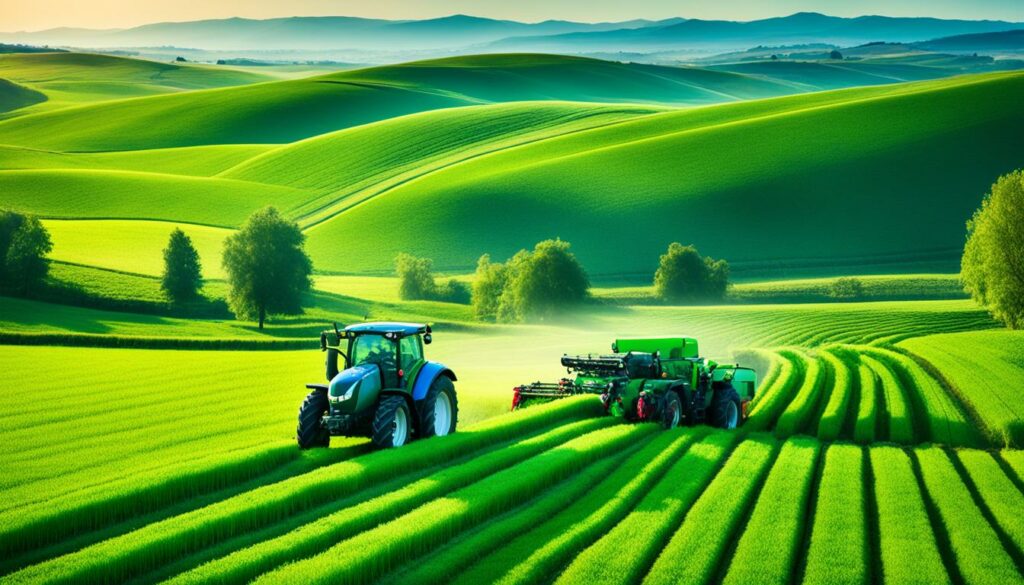
Using AI in farming can boost crop growth. It’s important because by 2050, we need to feed more people. AI looks at data to choose the best times to plant and harvest. This means better crops that match what’s needed and the weather.
AI in farming also means farmers can use resources better. It helps control watering to save water. Plus, it finds and fixes leaks early, so there’s less crop damage.
| Resource | Cost Savings Percentage |
|---|---|
| Herbicides | 67-80% |
| Starter Fertiliser | 60% |
| Labour Costs | 85% |
| Seed, Fertiliser, Chemicals | 27% |
| Fuel, Electricity, Repairs | 20% |
New AI tech leads to smart and cheap farming. Precision farming and AI tackle the farm challenges of today. They make farming more efficient and cheaper.
The way we farm is changing fast, thanks to automation. By 2050, the world will have nearly 10 billion people to feed. This puts a big demand on farming to produce more. We need new ways to be more efficient with our farming and use resources better than before.
Farming is costly, and more than half of these costs come from the workforce. However, farmers are often short of help, affecting their daily work. Automatic farming tools, like self-driving tractors, are a big help.
These machines can work all day, doing precise tasks over large fields. For example, one strawberry harvesting robot can do the job of 30 people in just three days on a 25-acre farm.
AI tools bring a new level of precision and efficiency to the farm. They can monitor crops in real time and spot diseases early. This means we lose fewer crops. AI also helps us use resources better, cutting down on waste.
By using smart vision, AI in farming can also reduce pesticides by 90%. This supports farming in an eco-friendly way. It also helps produce better and faster crops, which more people today want to be organic and eco-friendly.
| Challenges | Automated Solutions | Benefits |
|---|---|---|
| Labour Shortages | Automated farming equipment | Enhanced productivity and efficiency |
| High Labour Costs | Driverless tractors | Cost reduction |
| Excessive Pesticide Use | Precision AI tools | 90% reduction in pesticides |
| Resource Wastage | AI-driven farming tools | Optimised resource utilisation |
The change in how we work on farms is crucial. Using more automation and AI not only solves the problem of fewer workers but also makes farming more productive. It’s the future of agriculture.
The global population is set to hit 10 billion by 2050. This growth calls for new ways to increase food production. Artificial intelligence (AI) and agriculture coming together can help. They offer promising solutions to the world’s need for more food. Real-world AI applications are key to making this happen.
Enhancing irrigation systems stands out. With smart technology in greenhouses and self-governing crop care, farmers hit the sweet spot for soil moisture. This boosts the health and output of crops. AI uses on-the-ground data to fine-tune watering. It makes sure every drop counts, responding to the weather and soil conditions constantly.
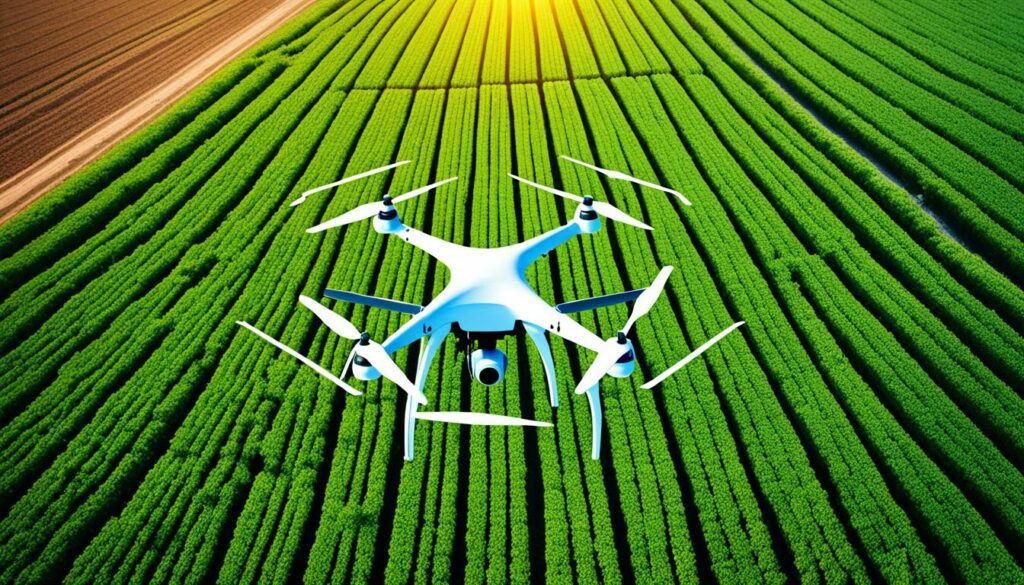
Good irrigation means getting just the right amount of water to crops, alongside sharp maintenance. AI steps in big for spotting leaks and fixing them fast. It uses machine learning to check up-to-the-minute data, stopping water wastage and preventing crop harm. These setups highlight how AI smoothly improves established farming routines, making them more effective and green.
| AI Application | Benefit |
|---|---|
| Optimised Irrigation Systems | Enhanced crop health and yield through smart greenhouse technology |
| Leak Detection | Reduces water waste and mitigates crop damage with AI monitoring |
| Autonomous Crop Management | Automates environmental condition adjustments |
Precision farming and smart agriculture are changing how we look after crops. By 2050, we will have 10 billion people to feed. This means farms must grow more food and save resources. Luckily, new technologies offer ways to do this well.
Drones and satellites play a big role in precision farming. They give farmers detailed information on crop health, pests, and soil. With this real-time data, farmers can use water, fertilisers, and pesticides more wisely. This means they get better results from fewer resources.
IoT sensors add a lot to monitoring crops. They track soil moisture, temperature, and nutrient levels. With the help of AI, these sensors predict what needs to be done. This helps farmers make smart choices about when to water, fertilise, and harvest.
The AI in agriculture market is set to triple from 2023 to 2028, reaching USD 4.7 billion. Precision farming can cut costs by 10-20% and boost yields by 10-15%. This shows it’s good for the environment and the economy. By using these technologies wisely, we can meet food demands sustainably as the world’s population grows.
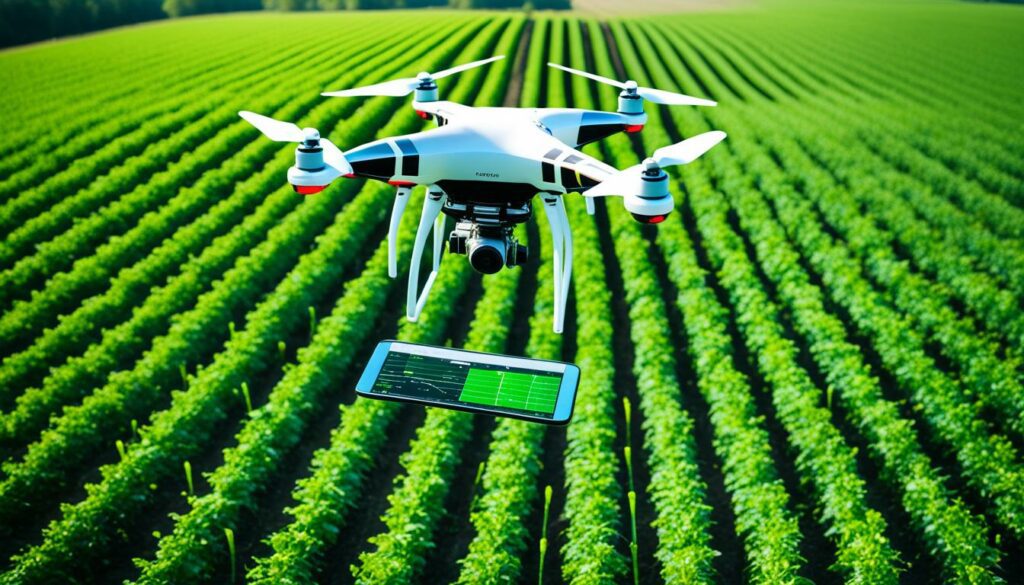
AI is changing the game with crop yield forecasting. It uses predictive analytics to make forecasts more accurate. It looks at historical data and current weather patterns. This helps farmers get ahead with their crop planning.
Data is key for predicting crop yields. It includes past climate, crop data, and plant health info. These details help teach AI algorithms how to predict, using methods like LASSO and neural networks. The more data they get, the better they become at forecasting.
Experts use weather analysis to guess future crop harvests. This lets them plan smarter, deciding when to plant and harvest. For example, tech that scans fields from afar, along with smart AI, can analyse a lot of data fast. As a result, their crop predictions are very accurate.
Now, AI is getting better at predicting crops like corn, wheat, and fruits. This is crucial for feeding people around the world. It helps us get ready for changes in the weather and the environment.
To conclude, predicting crop yields is both a tech feat and a huge help in farming. With AI getting better and data improving, forecasting has become a major aid for farming success and saving the planet.
Using AI-driven solutions changes how we deal with farm problems like pests and diseases. It’s vital because the world’s population is growing and will hit 10 billion by 2050. AI pest management is key. It quickly finds problems and acts to stop them, boosting crop growth and saving food.
AI drones and sensors lead in finding plant diseases in real time. They’re more than 90% accurate in spotting bugs like flies. This quick action can save up to 40% of the world’s crops that would otherwise be lost to pests.
AI pest management also cuts down on harmful chemicals, supporting green farming. Tools like Agrio use less pesticide, nearly 80% less. This protects the environment, crops, and the life around farms.
Using AI in farming helps us deal with problems wisely. As the use of AI in farming grows, from USD 1.7 billion in 2023 to USD 4.7 billion by 2028, we depend more on tech to secure our food’s future.
AI technology is now key in changing how we manage crops. It uses data to improve farming. By 2050, with a population of 9.8 billion, there’s huge pressure on farming to increase its output. AI does this by using predictive analytics, automation, and spotting crop diseases early.

Farming with AI gives us a deep look into crop health. It lets farmers make smart choices. This is done with quick analysis of lots of data, offering useful advice fast. With AI’s help, farmers can act in time to stop crop diseases and pests. This can save about 40% of the world’s crops. With AI, knowing the perfect time to plant, harvest, or treat crops can increase yields by up to 70%, according to CropX’s success stories.
Managing resources well in farming is crucial today. Challenges like less land, not enough water, and the harm from intense farming are serious. AI in farming uses precision methods to use water, fertiliser, and pesticides better. This cuts waste and boosts crop output. For example, CropX has lowered water use by 57% and reduced fertiliser by 15%. This smart use of resources boosts farming’s sustainability and meets our need to increase food production by 60% in 2050.
Using AI in monitoring livestock health shows how artificial intelligence is vital in farming. It makes farm management better by checking on animals in real time. This helps find diseases and injuries quickly, so actions can be taken before they get worse. AI is key in keeping animals healthy and productive.
AI in livestock health also means using smart ways to label data, making it good for machines to learn. Systems like LabelGPT can label images well and quickly, without humans needing to do it. It also tells how sure it is about the labels, making the data reliable for AI.
Advanced farming systems now watch how much animals eat and make sure they get the right food. They use sensors to measure the animals’ body conditions. This gives farmers a lot of info on their animals’ health and well-being. These smart systems help farmers do better, becoming more productive and making more money.
AI is amazing at spotting when animals are stressed or not feeling well. This is big for animal care as it helps in treating them when they need it. CattleEye is a leading example of how AI is changing livestock management by watching animals closely.
| Benefits of AI in Livestock Health Monitoring | Details |
|---|---|
| Real-Time Monitoring | Vision AI can optimise feeding schedules and grazing patterns through real-time tracking. |
| Early Disease Detection | AI technologies can identify signs of illness or injury, enabling prompt interventions. |
| Enhanced Animal Welfare | Monitoring systems identify signs of stress and discomfort, improving animal welfare. |
| Data Annotation Efficiency | Innovative methods like semantic segmentation and tools like LabelGPT increase data accuracy. |
| Optimised Nutritional Programs | AI algorithms analyse and adjust nutritional plans, improving feed efficiency and health. |
Intelligent pesticide application, powered by AI, has changed farming for the better. It has found the perfect mix between protecting crops well and looking after the planet. As the world’s population is expected to hit 9.8 billion by 2050, farming faces growing needs. AI brings precision to pesticide use, cutting down on overspray and harm to nature.
The use of AI in green farming means better technology for predictions, working automatically, and spotting crop diseases early. This advanced tech makes sure pesticides are used in the best way, keeping the environment safe. And it’s needed more than ever, with farming needing to grow smart due to less land and soil problems.
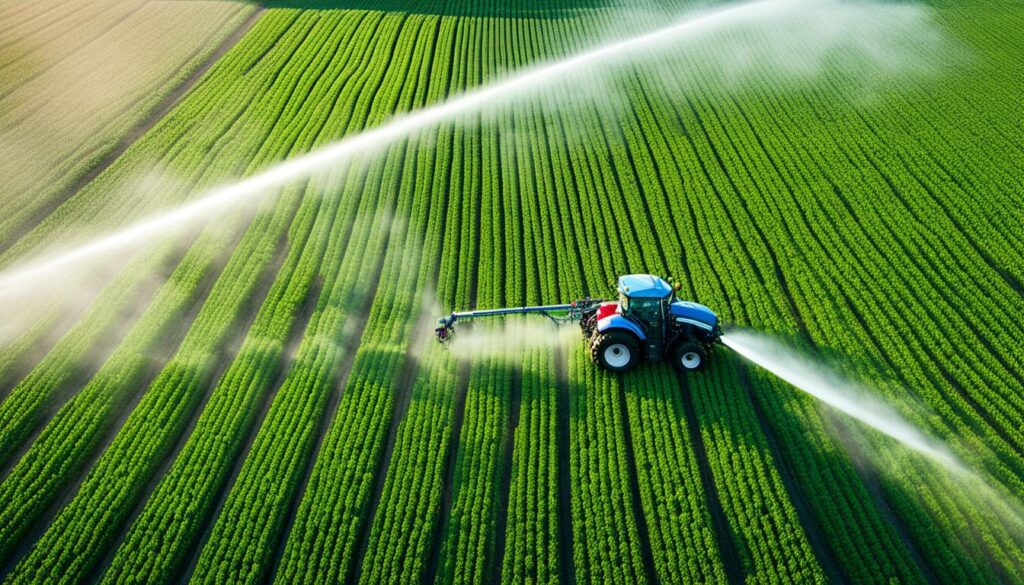
High-tech pesticide use saves both our planet and money in farming. With the help of AI, drones and sprayers aim precisely at the areas that need it. This cuts down on waste and lets us use up to 90% less chemicals, a big win for places like cotton farms already making use of this technology.
Using real-time data and smart predictions, farmers are able to choose the best actions. It makes farming strong against the challenges of our changing climate and keeps it affordable.
By 2050, we’ll have up to 10 billion people worldwide. This big number means our farms need to produce more food smartly. Yield mapping and AI predictive analytics are helping in big ways. They gather data from sensors and photos taken by drones. Then, intelligent algorithms turn this into information farmers can use. This helps them make smart choices about their crops.
New tech like yield mapping can guess how well soil will help grow crops. It uses smart computer programs to figure this out. With this knowledge, farmers can change their plans quickly to use their land better. The FAO thinks using these smart tools could boost food production by 70% in just a few decades.
AI predictive analytics are also great at keeping crops healthy. They can spot diseases in plants amazingly well, like apple black rot. Their accuracy is over 90%! This means farmers can act fast to stop diseases from spreading. It helps keep food on our tables by looking after the plants very well.
| Technology | Benefit | Impact |
|---|---|---|
| Yield Mapping | Predicts soil productivity | Informs optimal planting decisions |
| AI Predictive Analytics | Real-time data analysis | Enhances decision-making accuracy |
| AI-powered Drones | Determines precise pesticide application | Reduces chemical usage |
SoilPal and UjuziKilimo are good examples of what AI can do in farming. SoilPal checks the soil right away for nutrients, pH, and temperature. This helps farmers pick the best food for their plants. UjuziKilimo uses AI and the internet to give instant updates on soil health. This info is key for using resources wisely.
McKinsey & Company says AI in farming can be great for the planet. They think it could cut down on greenhouse gases by 15% by 2030. These smart tools don’t just help farmers. They make farming friendlier to the environment and more efficient.
Machine learning is revolutionising farming, making traditional methods more efficient. It brings new ideas to crop breeding and allows for very precise spraying. This technology is so powerful that it is altering every sector, says MIT expert Aleksander Madry. Farmers are increasingly using these tools to grow more food for a growing world.
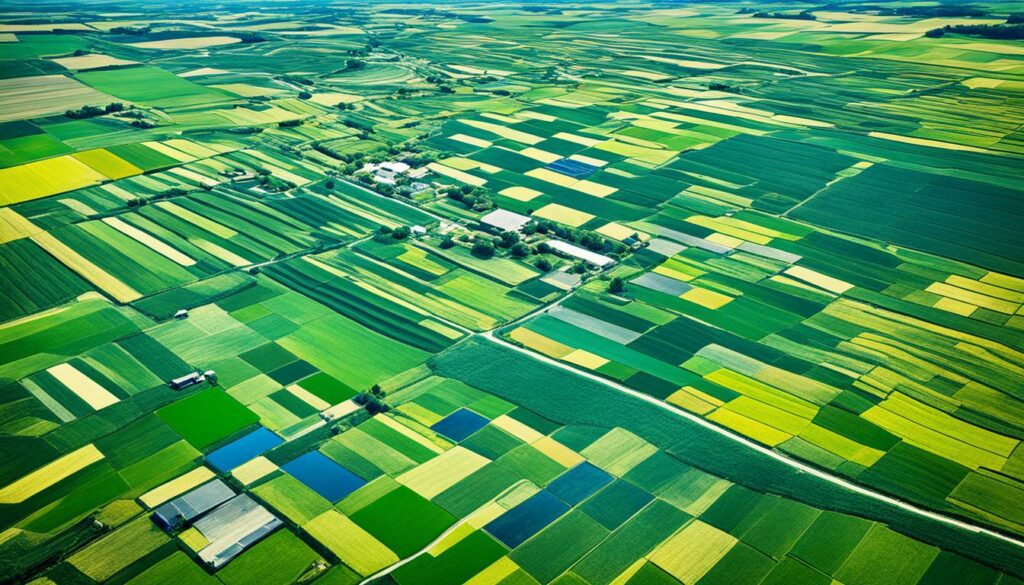
Machine learning is boosting the way we breed crops. It looks at huge amounts of data to create better plants. These new crops can face tougher weather and other challenges. This means we can grow food for more people, which is vital for the future.
*Machine learning* also helps with smart spraying. With ML, companies can spot and get rid of weeds in a very precise way. This means using less chemicals while keeping the land healthy. It’s part of a bigger trend to farm in ways that are kinder to our planet and more efficient.
The future of AI in agriculture looks bright, with big steps forward in robotics and data use. But, there’s a big hurdle in the way. This is the challenge of following new rules as farming becomes fully automated.
Things like self-driving tractors and smart harvesters are changing farming for the better. They make farming more efficient and help fill the need for more workers. These machines can work more accurately than people. This shows how farming is changing, being more innovative. But, using these new machines more requires a lot of money and effort from farmers and others in the field.
It’s vital for farmers to easily use all the data they collect. This lets them make quick decisions and use their resources better. But, using more AI in farming is hard because of new rules. The world keeps changing its laws about protecting data and what tech can do. We need strong and fair rules that let new ideas in farming grow but also keep everyone safe and respected. So, everyone from lawmakers to tech experts to farmers must work together. They need to come up with rules that both help new technology and protect people’s rights.
| Key Areas | Future Directions | Challenges |
|---|---|---|
| Robotics and Autonomous Equipment | Expanded use in various farming operations | High upfront costs and technological adaptation |
| Data Accessibility | Real-time insights and decision-making | Lack of uniform data standards |
| Regulatory Frameworks | Support for innovation in AI | Navigating data privacy and usage laws |
By 2050, the world’s population will likely reach 10 billion. AI’s role in farming is huge. It’s leading the way to smart and sustainable farming. This jump in AI use could see the market grow from USD 1.7 billion in 2023 to USD 4.7 billion by 2028.
AI is making farming smarter in many ways. It can spot crop diseases with more than 90% accuracy. It’s also helping farms use water better and apply pesticides more precisely with drones.
Plus, companies like CattleEye are using AI to look after livestock better. They use AI and ML to know when animals need help. AI also helps farmers make better decisions with things like managing crops autonomously and mapping yields, all based on data.
So, the future of farming is all about using AI. This tech offers hope. It makes sure farming evolves to feed more people without harming the planet. With AI, farming can be strong, efficient, and good for the earth. AI isn’t just a tool. It’s the key to a successful future for farming, bringing in a new time of growth and health for agriculture.
AI is transforming agriculture, making it more productive and secure. It uses data for better farming quality and efficiency. This includes improving crop management and tracing food.
By 2050, the world’s people might hit almost 10 billion. AI in farming helps grow more food sustainably. It boosts farm efficiency and uses resources better.
Farmers deal with small land and not enough workers, plus changing climate. Also, the soil’s health is getting worse. AI helps by using data, learning about soil, and smart crop tools. This makes farming more effective and deals with these issues.
AI’s analytics predict the best times to plant and when to harvest. Knowing what the market needs helps farmers make the right choices. It makes farms more productive.
AI can increase yields and save on resources. This means more crops with less money spent. It’s through smart soil care, useful data, and focused actions.
AI tools and machines make farming more precise and efficient. This change is because of smart machines, which help with missing workers. Farms are now more productive and smarter than before.
AI is used in smart watering systems, spotting leaks, and managing crops without help. It’s in greenhouses and fields, making sure plants grow well.
Drones, satellites, and sensors show what crops need. AI uses this to water and fertilise fields just right. This makes farming more accurate and less wasteful.
AI uses old and current data to guess how much a farm will produce. This helps plan a farm’s year, from what to plant to how to pick crops. It makes farms run smoother and smarter.
AI spots diseases and pests early, without extra chemicals. It sees and treats exact areas, saving the environment and crops.
By looking at crop health and what they need, AI helps farms use resources better. This makes farms more productive and follows good farming practices.
With special tech, AI watches over animals. It can tell if something’s wrong, helping the sick quickly. It makes looking after animals easier and better.
This is smartly spraying, not just everywhere. AI tech in drones and sprayers helps protect the earth. It’s a better way to deal with pests.
These show how crops are doing and help plan the farm’s future. AI combines data to predict soil productivity. It’s how farms make informed decisions for the future.
Machine learning predicts which crops will do best. It also applies herbicides and pesticides exactly where needed. This makes farming more effective.
AI’s future is in more farming robots and moving away from manual work. But, we must make sure everyone can use the data and follow rules. This is important for fair and right AI use on farms.